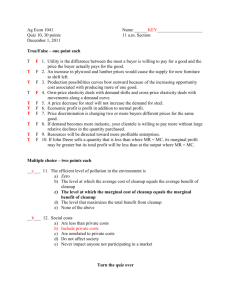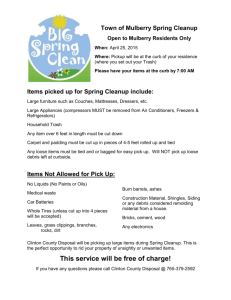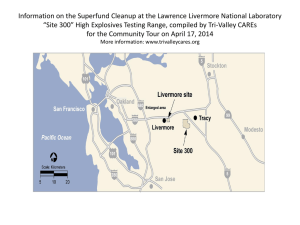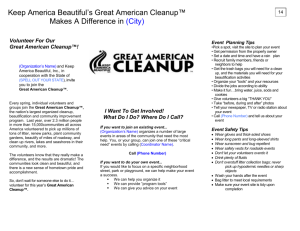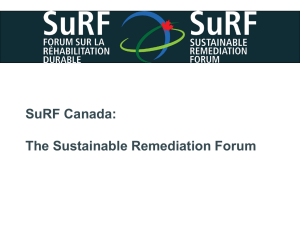Statement of Jessie H. Roberson Assistant Secretary for Environmental Management
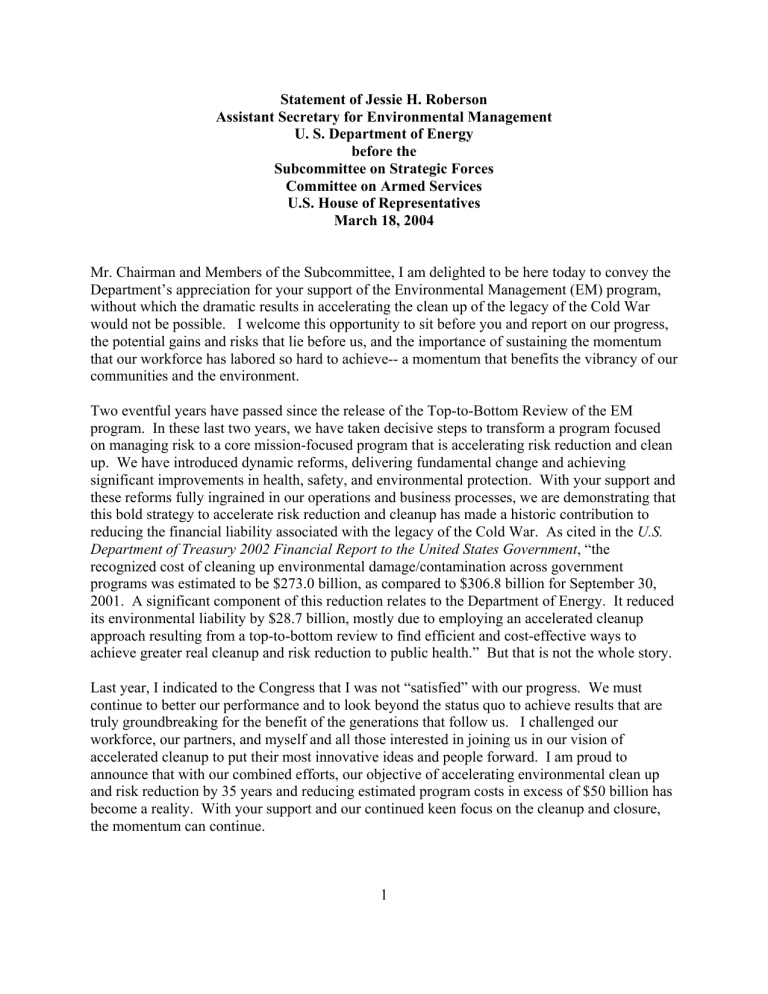
Statement of Jessie H. Roberson
Assistant Secretary for Environmental Management
U. S. Department of Energy before the
Subcommittee on Strategic Forces
Committee on Armed Services
U.S. House of Representatives
March 18, 2004
Mr. Chairman and Members of the Subcommittee, I am delighted to be here today to convey the
Department’s appreciation for your support of the Environmental Management (EM) program, without which the dramatic results in accelerating the clean up of the legacy of the Cold War would not be possible. I welcome this opportunity to sit before you and report on our progress, the potential gains and risks that lie before us, and the importance of sustaining the momentum that our workforce has labored so hard to achieve-- a momentum that benefits the vibrancy of our communities and the environment.
Two eventful years have passed since the release of the Top-to-Bottom Review of the EM program. In these last two years, we have taken decisive steps to transform a program focused on managing risk to a core mission-focused program that is accelerating risk reduction and clean up. We have introduced dynamic reforms, delivering fundamental change and achieving significant improvements in health, safety, and environmental protection. With your support and these reforms fully ingrained in our operations and business processes, we are demonstrating that this bold strategy to accelerate risk reduction and cleanup has made a historic contribution to reducing the financial liability associated with the legacy of the Cold War. As cited in the U.S.
Department of Treasury 2002 Financial Report to the United States Government , “the recognized cost of cleaning up environmental damage/contamination across government programs was estimated to be $273.0 billion, as compared to $306.8 billion for September 30,
2001. A significant component of this reduction relates to the Department of Energy. It reduced its environmental liability by $28.7 billion, mostly due to employing an accelerated cleanup approach resulting from a top-to-bottom review to find efficient and cost-effective ways to achieve greater real cleanup and risk reduction to public health.” But that is not the whole story.
Last year, I indicated to the Congress that I was not “satisfied” with our progress. We must continue to better our performance and to look beyond the status quo to achieve results that are truly groundbreaking for the benefit of the generations that follow us. I challenged our workforce, our partners, and myself and all those interested in joining us in our vision of accelerated cleanup to put their most innovative ideas and people forward. I am proud to announce that with our combined efforts, our objective of accelerating environmental clean up and risk reduction by 35 years and reducing estimated program costs in excess of $50 billion has become a reality. With your support and our continued keen focus on the cleanup and closure, the momentum can continue.
1
For fiscal year 2005, the President’s Budget includes a record $7.43 billion for the accelerated cleanup program, the peak year in our funding profile. As we identified last year, the
Administration believes that this investment is crucial to the success of accelerated risk reduction and cleanup completion. We anticipate funding will then decline significantly to about $5 billion in 2008.
The EM portion of the fiscal year 2005 Congressional budget is structured analogous to last year.
The budget structure focuses on completion, accountability, and visibility; institutionalizes our values; and integrates performance and budget. Requested funding can clearly be associated with direct cleanup activities versus other indirect EM activities.
Within the Defense Site Acceleration Completion Appropriation, the budget reserves $350 million for a High-Level Waste Proposal. With the Idaho District Court decision on Waste
Incidental to Reprocessing, the Department’s ability to proceed prudently with accelerated risk reduction for some activities is drawn into question. The decision makes it difficult, if not impossible, for us to undertake planned actions at Idaho, Hanford and Savannah River Site to aggressively reduce risks posed by wastes stored in tanks at those sites – actions we had committed to take, in agreement with our host states, before the court decision. The decision now means we are likely to leave tank wastes in place longer while we try to resolve issues created by the decision – a course that has significant societal and monetary costs. This $350 million supports activities normally funded from the 2012 Accelerated Completions account and from the 2035 Accelerated Completions. These funds will be requested only if the legal uncertainties are satisfactorily resolved.
In alignment with ongoing Departmental missions, this budget reflects a transfer of multiple activities that are not core to the EM mission to other Departmental elements. These transfers provide the responsible and accountable mission programs with the resources and tools to achieve their objectives at the expected performance level. This accountability model is the key to moving each of the enterprises or missions of the Department forward in attaining the desired outcomes and results important to the Administration and supporting our accelerated risk reduction and closure initiative. Transfers include:
• Transferring federal staff at the Pacific Northwest National Laboratory to the Office of
Science and federal staff at Headquarters to the Office of the Chief Information Office.
• Transferring the EM portion of the Offsite Source Recovery Program to the National
Nuclear Security Administration.
• Transferring spent fuel storage responsibilities at Idaho National Laboratory, the Foreign
Research Reactor Spent Fuel Program, management of NRC-licensed spent fuel, and the
National Nuclear Spent Fuel Program to the Office of Civilian Radioactive Waste
Management.
• Transferring Formerly Utilized Sites Remedial Action Project records management, responsibility for cost liability and recovery reviews, and Environmental Justice and the
Massie Chairs of Excellence Program to the Office of Legacy Management (LM).
2
We will also be transferring sites, as they are completed, either to the landlord or to LM. The latter will occur if the site has no further DOE mission. EM is working with LM to ensure smooth site closure and transition by:
Ensuring that site baselines identify functions and elements beyond contract closure to meet all internal requirements;
Conducting assessments of site readiness for transfer and closure in tandem with
LM;
Having joint teams at each site (Rocky Flats has 2 LM employees) and supported by HQ LM personnel who were once EM personnel and EM personnel at sites are transferring to LM positions;
Holding quarterly meetings between EM and LM senior management to address key issues and make decisions;
Developing a communication plan defining roles and responsibilities between EM and LM staff.
The Administration considers this budget request a critical step on the accelerated risk reduction and cleanup path. Without these resources, we could face higher risk to the environment and the public and lose the momentum we have gained in changing the paradigm. With your support, we have the opportunity to succeed in producing historic results that will last for many years to come.
DEMONSTRATING RESULTS
With the October 2003 release of the Report to Congress on the Status of Implementation of the
Top to Bottom Review, we have demonstrated that the direction we took two years ago is showing real results. I wish to take a moment and expound the impacts of the far-reaching accomplishments that are underpinning the developing momentum of the program.
Improved Safety Performance
We believe in order to accomplish our accelerated risk reduction and clean up mission, we must continue to do work safely. We are committed to instilling this philosophy in every worker’s day-to-day decisions from start to finish of every project. To that end, with top-quality safety standards, we are demonstrating that we can accelerate work and improve safety performance at the same time. For example in August 2001, EM’s Total Reportable Cases (TRC) and Lost
Workday Cases (LWC) were 1.9 and 0.8 respectively, per 100 workers (TRC and LWC are standard tools used to measure safety performance). In September 2003, we had reduced our
TRC to 1.2 and LWC to 0.5. These rates are significantly better than private industry, which
OSHA reported in 2002, had a TRC of 5.3 and LWC of 1.6. The construction industry alone had rates of 7.1 for TRC and 2.8 for LWC in 2002. We have not nor will we stop paying attention to safety. We will continue to “raise the bar” and hold ourselves accountable to the highest standards. Complacency is not acceptable in our advance to the safe conclusion of our clean up objectives.
3
Cleanup Results and Risk Reduction
Prior to the Top to Bottom Review, EM had lost focus of the core mission, the mission that the program was established to solve----address the environmental legacy of the Nation’s Cold War nuclear weapons research and production. With a program responsible for the management of millions of gallons of liquid radioactive waste and thousands of tons of spent nuclear fuel, the unhurried pace of cleanup and risk reduction was unacceptable. If immediate actions were not taken the risks associated with the EM program would continue to grow to unpardonable levels.
Last year set a new floor of performance not seen before in the history of the program. Our investment has born amazing results. For example: three spent nuclear fuel basins were deinventoried at Idaho National Laboratory, along with two at the Savannah River Site and one at
Hanford. And in regard to Hanford, we have removed 70% of the spent nuclear fuel from the K-
Basins. These basins located less than a quarter of a mile from the Columbia River have the potential to leak and cause costly environmental harm both to the health of the river and the public--this is a significant gain in risk reduction. Another example is at Rocky Flats. This site, once responsible for nuclear triggers, has shipped all plutonium off site and closed the last remaining material access area. These visible, risk reducing results that have demonstrated our ability to accelerate schedule and reduce life cycle cost while showing to our public and surrounding communities the Department’s commitment to improve worker safety, reduce health risks and eliminate environmental hazards.
So you may have a better comprehension of the magnitude of our cleanup results, I would like to insert for the record a copy of our recent corporate performance measures. EM’s Performance
Measures is a compilation of the program’s sixteen complex wide performance measures. As you can see, we can deliver significant risk reduction and cleanup and, as I stated earlier, in combination with improved safety performance. Accelerating risk reduction and cleanup, in concert with exceptional safety performance, accomplishes consequential outcomes important to the public, our communities, and for the generations that follow us.
Innovations in Ideas, Processes, and Practices
Two years ago, the Top-to-Bottom Review described the EM program as lacking a project completion mindset, internal processes were inconsistent with a risk-based cleanup approach, and the hazards at the DOE sites and the liability associated with them did not appear to dictate the need for urgency in the cleanup decisions. The Top-to-Bottom Review team emphasized that the EM mission cannot be accomplished by continuing business as usual. Innovative actions in all elements of the EM program would need to be taken to transform DOE’s processes and operations to reflect the new accelerated risk-based cleanup paradigm.
To foster innovation, we identified ideas and processes from successful projects that had delivered accelerated results and conveyed the information across the EM program. For example, at Rocky Flats, we drew from their experience in project planning and delivery along with technology advancements. Sharing the innovative practices allowed for similar outcomes at other sites. If I may take a moment to share a few ideas and practices:
4
a) Establish a clear end-state vision and risk-based cleanup levels in conjunction with specific future land/site use and in consultation with regulators, stakeholders, and affected and interested governments. b) A “best-in-class” management team is recruited and sustained with the result of team focus and retention of key staff. c) Senior management emphasis is placed on key safety issues of keeping workers working, minimizing the risk of possible high-impact events, quick recovery after accidents, safety “pauses” as appropriate, and improved safety training. d) Projects are managed in an environment that provides significant incentives for real cost savings. e) New and innovative equipment and methods are being used for size reduction (e.g. plasma cutting torch, engineered enclosures, water-jet cutting of components), significantly improving safety and effectiveness. f) Improved decontamination techniques coupled with new radiation instrumentation.
We continue to encourage innovation in our processes and practices to further enhance safety performance, accelerate risk reduction, reduce health impacts, and save resources to be reinvested in furthering the priorities of each of the sites.
Acquisitions Driving Performance
Tying all these accomplishments together has been our continued drive to improve performance from our new acquisition strategy. These accomplishments serve as indicators of the level of performance we are expecting from our contractors now as well as into the future. When we reviewed our contracts over the past year—as you may remember I said we formed a Contract
Management Advisory Board last year--- we identified a short list of significant findings that did not prove advantageous to the overall success of the program. We concluded that DOE tends to manage the contractor not the contract, that project baselines needed improvement along with project management and the associated reporting, incentives for meaningful risk reduction were lacking, more emphasis was needed on cost-efficient performance, and there seemed to be insufficient competition and small business participation.
To address these weaknesses, we have instituted three business models that we believe will vastly improve our acquisition process and opportunities for success. Our reform strategy is to accelerate the reduction of risk from the legacy of the Cold War safely and efficiently and at a cost savings for the taxpayer. One model focuses on improving incumbent contractor’s performance, while another aims to increase competition and small business participation. The third concentrates on the establishment of national Indefinite Delivery/Indefinite Quantity (IDIQ) contracts for remediation and decontamination and decommissioning. All three are on the fast track. In fact, in September, as a first step we announced the selection of five 8(a) businesses that will perform work at our small sites across the country. And in fiscal 2004, we have six new contracts---two at Paducah, two at Portsmouth, one at the Fast Flux Test Facility at Hanford, and one at the Idaho National Laboratory along with the IDIQ contracts that will be competed. We expect these new contracts will challenge the contractor community, a challenge that is healthy for all involved.
5
We Have Our Challenges Too
As we continue to challenge the status quo, we may be confronted with legal actions and court decisions that will direct us to alter or modify our activities from the accelerated cleanup and closure path. We will continue to work diligently with all concerned parties to avoid interruptions in reducing risk and advancing cleanup for the public.
We expect to be challenged on our delivery of Government Funded Services and Items, or GFSI.
We are accountable on delivery of GFSI and we expect to be held to our commitments.
Also, we have challenged our managers at all levels to stay true to our commitment and employ our corporate performance measures as an accountability and success gauge assessing our progress as well as a tool that alerts us when management action or intervention is warranted.
THE FY 2005 BUDGET REQUEST
The FY 2004 budget was the first budget that fully reflected the initiatives undertaken by the
Administration to transform and revitalize the cleanup of the former weapons complex. The EM program has been refined and fortified with management reforms, which have led to accelerated risk reduction and a decrease in life-cycle costs surpassing previous expectations. The investment we have requested in our FY 2005 budget will contribute to EM’s continued success in achieving its mission of accelerated risk reduction and site closure.
The EM FY 2005 budget request represents the peak year of our investment strategy to accelerate cleanup and reduce risk. This budget fully reflects each site’s accelerated risk reduction and cleanup strategy. The FY 2005 budget request is pivotal to keep the momentum going and to achieve even greater risk reduction and cost savings than ever before.
The 2005 budget request for EM activities totals $7.43 billion to accelerate risk reduction and closure. The request includes five appropriations, three of which fund on-the-ground, core mission work, and two of which serve as support. The five appropriations and associated requested funding are:
• Defense Site Acceleration Completion ($ 5.97 billion)
• Defense Environmental Services ($ 982 million)
• Non-Defense Site Acceleration ($ 152 million)
• Non-Defense Environmental Services ($ 291 million)
• Uranium Enrichment Decontamination and Decommissioning Fund ($ 500 million)
Within the Defense Site Acceleration Completion Appropriation, $ 350 million is tied to the
Idaho District Court decision on Waste Incidental to Reprocessing. These funds will only be requested upon satisfactory resolution of the recent court decision that affected the Department’s plans for some waste streams.
In building the request, the Department applied the following principles and priorities:
6
Protect workers, public, and the environment : The budget request continues to place the highest priority on protecting workers, the public, and the environment. The implementation of EM’s cleanup strategies allows for an overall improvement in safety and reduction in risk because cleanup will be completed sooner, reducing the extent to which workers, the public, and the environment have the potential to be exposed. Over the past two years, dramatic improvements in safety performance have been demonstrated.
Ensure the appropriate levels of safeguards and security: Due to heightened security levels throughout the nation, it is crucial that we maintain vigilance in our domestic security to protect our citizens. The EM program is responsible for many tons of surplus nuclear material. This budget request reflects our increased safeguards and security needs, including the new Design
Basis Threat requirements. Overall, the budget has decreased from FY2004 because we have been able to consolidate materials into fewer, more secure locations, and we have reduced the footprint of secure areas. The sites with the largest remaining funding needs are the Savannah
River Site and Hanford. Savannah River Site’s funding supports the security of nuclear materials, maintenance of uniformed protective force personnel, information security and operations security for the protection of classified and sensitive information, cyber security for the protection of classified and unclassified computer security, and personnel security.
Hanford’s funding supports security for shipment of special nuclear materials and elimination of one Material Access Area within the Plutonium Finishing Plant, enhancement of cyber security,
Hanford site security clearances and other security activities.
Accelerate risk reduction: Accelerated risk reduction requires a pragmatic approach to cleanup.
Risk reduction occurs in various stages, which involve the elimination, prevention, or mitigation of risk. Because safe disposal of many materials will take a number of years to complete, our major focus of risk reduction is stabilization of high-risk materials.
The following categories of materials are considered to pose the highest risk:
• High-curie, long-lived isotope liquid waste
• Special nuclear materials
• Liquid transuranic waste in tanks
• Sodium bearing liquid waste in tanks
• Deteriorating spent nuclear fuel in leaky or poor integrity basins
• Remote-handled transuranic waste and high transuranic content waste
• Transuranic waste stored on the surface
• Decommissioning of highly-contaminated facilities
Although all of these items are to be considered when setting priorities, their relative ranking may vary from site to site. Risk reduction is a major consideration in the development of the site baselines. Examples of planned activities/milestones for FY 2005 that correspond to sitespecific risk categories are:
Hanford
• Complete cleanout of K East and K West basins (fuel, sludge, debris, and water).
7
- The K basins are located less than 1,000 feet from the Columbia River. This project involves packaging and removing degrading spent nuclear fuel and radioactive sludge, debris, and water from wet storage in the K Basins to safe, dry interim storage away from the Columbia River. The K Basin facilities are well past their design lives and are a major threat to the environment due to the potential for basin leakage to the surrounding soil and the Columbia River. Their cleanout will prevent potential leakage of 55 million curies of radioactivity to the soil and the River and will decrease the risks posed by the basins to human health and the environment.
• Complete transfer of nuclear material to the Savannah River Site or DOE approved interim storage facility, and complete legacy holdup removal and packaging/disposition of material/waste.
-
The Plutonium Finishing Plant (PFP) consists of several buildings that were used for defense production of plutonium nitrates, oxides and metal from 1950 through 1989.
Completion of the transfer of the stabilized materials and legacy holdup material from
PFP allows the cleanout and demolition of these facilities to slab on grade. It results in a reduced National security threat by consolidating nuclear materials into fewer locations.
• Ship all above-ground transuranic waste to the Waste Isolation Pilot Plant.
-
Hanford has several thousand containers of previously generated transuranic waste in above-ground storage buildings. Characterization and shipment of this waste to the Waste
Isolation Pilot Project for final disposal will reduce the risks to facility workers as well as reduce the safeguard and security vulnerability associated with this waste. This action represents final disposal of this waste in an environmentally protective repository.
• Complete installation of In Situ Redox Manipulation Barrier in the 100-D Area .
-
Chromium-contaminated groundwater is reaching the Columbia River in the 100-D Area.
The contamination levels are above 20 times the aquatic life water standard, and the area is adjacent to potential salmon spawning locations. To address this, a series of wells will be drilled and a chemical that detoxifies chromium will be deposited into the matrix in which the groundwater travels to the river. As a result, the groundwater reaching the
Columbia River will once again meet the aquatic water standards, thereby protecting
human health and the salmon population in the River.
• Initiate waste retrieval from eleven single-shelled tanks.
Radioactive liquid waste stored in older single-shelled tanks has the potential of leaking and contaminating soil and groundwater that flows to the Columbia River, presenting a risk to human health and the environment. Waste will be retrieved from the single-shelled tanks and moved to safer double-shelled tanks.
Idaho
• Disposition 34 containers of special nuclear material containing uranium, completing 75 percent of shipments offsite; initiate transfer of spent nuclear fuel from CPP-666 wet storage to the Irradiated Fuel Storage Facility; and maintain a running average of 2,000 cubic meters per year of TRU waste shipped out of Idaho.
8
-
Idaho sits over a major sole source aquifer, the Snake River Plain Aquifer, which is used to supply water to the people of southeastern Idaho as well as irrigation water for the significant agricultural activities. These actions will reduce the potential risk to human health by preventing the migration of contamination into the aquifer. It also will reduce the national security threat by consolidating materials into fewer locations.
Paducah
• Disposition 875 cubic meters of low-level/mixed low-level legacy waste, allowing for a 37 percent completion of work.
-
The packaging and disposal of low-level waste stored outdoors will reduce the waste inventory and eliminate the potential release into the environment that could result from deterioration of the storage drums. Outside storage of this material in some cases leads to additional surface water and soil contamination. Removal of these materials further reduces the continued exposure to workers performing surveillance and maintenance.
• Disposition 12,400 tons of scrap metal.
-
Scrap metal is a suspected source of continued surface water and possible soil contamination. This action contributes to the continued source term removal of contaminants leaching into the environment. Reduction in the massive quantities of scrap metal continues to improve the potential safety concern to our workers.
$
Continue decontamination and decommissioning of C-410 complex.
-
The C-410 Complex is a large chemical complex in a shutdown condition. Removal of contaminated materials and equipment reduces potential risk to onsite workers and represents a key step in stabilizing the facility such that contaminants are prevented from release to the environment.
Portsmouth
• Disposition 9,089 cubic meters of legacy waste.
-
The continued shipment and disposal of legacy waste will proportionally reduce the risk such wastes present to the health and safety of workers and reduce the on-going potential for release to the environment.
• Process approximately 42 million gallons of water through Groundwater Pump and Treat facilities.
-
Plume control keeps contaminants from reaching surface streams and off-site drinking water supplies. Trichloroethylene (TCE), which was an industrial solvent, is the main groundwater contaminant at the site.
Pantex Plant
• Complete Zone 11 soil vapor extraction for removal of contamination from the vadose zone and protection of the groundwater.
-
Removing the soil gas contamination will avoid potential migration to a fresh water supply, thereby reducing the risk posed to human health and the environment.
9
• Complete Burning Grounds landfills interim corrective measure (engineered covers) to secure wastes and protect groundwater.
-
The covers will mitigate the vertical transport of contaminants, which will reduce the potential impact to the fresh water supply.
• Complete demolition of Zone 10 Ruins.
-
The Zone 10 ruins have suspected high explosives contaminants in the numerous disintegrating structures. Removal of high explosive will avoid further contamination of soils, and demolition of the ruins will reduce safety risks to persons in the area.
• Complete decontamination and decommissioning of Building 12-24 Complex.
-
There is evidence that this complex contributed to the high explosives plume that migrated to the southeast and off-site. Decontamination of the 12-24 Complex will mitigate the migration of this plume.
Oak Ridge
• Complete East Chestnut Ridge Waste Pile Closure.
-
Risks associated with industrial safety will be reduced by eliminating the need to excavate and transport the material to treatment subsequent to disposal.
• Complete disposition of legacy low-level waste.
-
Approximately 40 percent of the low-level waste was stored outdoors in deteriorating containers. Disposition of this waste will decrease the risks associated with their potential environmental release.
• Complete processing and stabilization of transuranic waste tanks.
-
This action will eliminate the potential for the waste’s migration to groundwater.
• Initiate contact-handled transuranic waste processing at the Waste Processing Facility .
-
This waste is stored in above grade-storage trenches and in earthen trenches. Processing the waste prevents the risk of release to the environment and a continued cost of waste storage and monitoring.
• Complete treatment of liquid low-level waste supernate at the Waste Processing Facility and disposal of the dried supernate product at the Nevada Test Site.
-
Treatment and disposal of the supernate decreases the risks posed by these highly radioactive fission products.
• Complete Atomic City Auto Parts .
-
This action will reduce the risks posed to workers and the surrounding community from uranium and polychlorinated biphenyls contamination in the soil.
Savannah River Site
• Begin processing neptunium solutions.
10
-
SRS has approximately 6,000 liters of Neptunium-237 nitrate solution in H-Canyon.
Through processing, the neptunium solutions are converted into a more stable form, and the risks they pose to human health and the environment are reduced.
• Complete bulk waste removal in Tank 5.
- Tank 5 is one of 49 underground tanks currently used to store radioactive liquid waste at the Savannah River Site. This waste represents one of the highest risk to human health and the environment. Current plans call for the removal of the waste from Tank 5 for treatment, stabilization and disposal. A new approach, the Waste-On-Wheels (WOW) system, will be utilized to remove the waste from Tank 5 and other tanks. The Waste-On-
Wheels is a portable method of performing bulk sludge waste removal from the tanks.
The WOW system will reduce the project schedule for waste removal and therefore reduce the risk to human health and the environment imposed by the highly radioactive waste.
• Complete decommissioning of seven industrial and radioactive facilities.
-
Decommissioning excess radioactive facilities will reduce the footprint of the site, and therefore collectively reduces risk to the worker by eliminating the need to enter the facilities to perform required, routine surveillance and maintenance activities. Risk of worker exposures while performing these activities is eliminated. Decommissioning excess radioactive facilities also eliminates the potential environmental and human health risk of accidental releases from these facilities. Decommissioning industrial facilities eliminates the risk to workers associated with having to maintain old facilities which are no longer needed but which require regular inspections or maintenance activities, such as roof work.
Lawrence Livermore National Laboratory-Livermore Site
• Construct, install, and operate a portable treatment unit at Treatment Facility D Hotspot,
Treatment Facility E Hotspot, the northern portion of the East Traffic Circle Source Area, and the Treatment Facility 406 Hotspot area.
-
These actions will further prevent the release of trichloroethylene (TCE), thereby reducing risks to the public from exposure to contaminated groundwater.
• Remove contaminated surface soil and contaminated sandpile at Building 850.
-
These actions will mitigate risk to onsite workers, and will prevent further impacts to groundwater above health-based standards.
• Construct, install, and operate groundwater extraction and treatment facility.
-
Remediation of the high-explosive process area is a high priority due to the offsite migration of contaminant plumes, current impacts to onsite water-supply wells, and the inhalation risk to onsite workers. These actions will impede the migration of plumes, protecting offsite water-supply wells from contamination.
Maintain closure schedules: Three major sites, Rocky Flats, Fernald, and Mound, have accelerated closure schedules. In addition, two smaller sites, Ashtabula and Battelle-Columbus
11
are scheduled to close in 2006. Funding in the FY 2005 budget will allow these sites to remain on track toward project completion and site closure.
At Rocky Flats, FY 2005 funding provides for:
• Completing site deinventory of legacy low-level/mixed low-level and transuranic waste to off-site disposal; completing remediation of 30 release sites.
-
During FY 2005, Rocky Flats will be approaching completion of their commitment to closure and conversion of the Rocky Flats site for future beneficial use. The buildings where plutonium and other hazardous materials were used in support of the nuclear weapons deterrent will be under various stages of demolition, the final quantities of radioactive wastes will be removed from the site, and the grounds will be receiving the necessary remediation action. These actions, when complete, will allow the Department of Energy to release the site to the U.S. Fish and Wildlife Service to become the Rocky
Flats Wildlife Refuge with little or no further risk to human health or the environment.
At Fernald, FY 2005 funding provides for:
• Completing decontamination and dismantlement of the Waste Pits Complex and the East
Warehouse Complex, and completion of waste pits remedial action operations.
-
Completing the Waste Pit Remediation Project will result in over one million tons of waste pit material having been transported off-site via rail for safe, compliant disposal and the D&D of the treatment facility and other waste pit infrastructures. Completing these activities represents a substantial risk reduction to human health and the environment for the entire Fernald Closure Project site. This remediation activity is being conducted in an extremely safe manner considering the industrial hazards involved.
• Completing Silos 1 and 2 operations, including removal of waste material, and beginning disposition of the waste for off-site disposal.
-
Silos 1 and 2 Extraction and Treatment Operations represent the greatest risk to human health and the environment at the Fernald Closure Project. Silos 1 and 2 contain the highest levels of radiological activity residing in any waste stream at the site. The Silos 1 and 2 project constitute the Site Closure Critical Path. Their successful completion is a prerequisite for a timely and safe closure.
• Completing construction of the On-Site Disposal Facility Cell 3 and Cell 4 caps.
-
Capping Cells of the On-Site Disposal Facility (OSDF) will insure the reduction in risk to human health and the environment during post closure. Overall, the OSDF will be composed of 8 cells, containing 2.5 million cubic yards of waste soil and debris. The
OSDF has been designed and engineered to possess a 5-foot thick liner and a 9-foot thick cap. The OSDF has a design life of 1000 years.
At Mound, FY 2005 funding provides for:
• Completing remediation of 37 potential release sites (65 percent of remaining), including the restoration of potential release site (PRS) 66.
-
Completing the PRSs in FY2005 decreases risk by preventing any further radioactive contamination from migrating into clean soil areas and ground water, by reducing
12
potential exposure to site workers and other personnel located on site, and by precluding any potential environmental impacts to off site areas.
At Ashtabula, FY 2005 funding provides for:
• Completing remediation of the Waste Management Unit.
-
Remediating the Waste Management Unit significantly reduces the remaining risks of organic and inorganic chemical exposure to both soil and groundwater at the RMI site.
At Battelle-Columbus, FY 2005 funding provides for:
• Completing decontamination/stabilization of the fuel storage pool and transfer canal and the high-bay area surfaces in JN-1.
-
Removing this source term will reduce the risk of contamination, both internal and external, to the workers during building de-construction. Removal of the source term would also reduce risk to off-site areas and members of the general public.
Integrate technology development and deployment: An integrated technology development and deployment program is an essential element for successful completion of the EM cleanup effort and for fulfilling post-closure requirements. The EM Technology Development and Deployment
(TDD) program provides technical solutions and alternative technologies to assist with accelerated cleanup of the DOE complex.
EM technology development and deployment investments are focused on high-payoff site closure and remediation problems through a two pronged approach: Closure Projects and
Alternative Projects.
Closure Projects: Principal near term closure sites (such as Rocky Flats, Fernald and Mound) will be provided with technical support and quick response, highly focused technology development and deployment projects. The goal is to ensure that accelerated site closure schedules are achieved.
• At Rocky Flats closure site, technical assistance teams will assess critical technical issues and provide technology alternatives including the treatment and disposition of orphaned waste streams and improved methods of beryllium decontamination.
• At Mound, innovative technologies will be developed to determine and enable treatment of radioactive contaminated soil beneath buildings.
• At Fernald, the vacuum thermal desorption demonstration will be completed to provide a technical solution for an orphaned waste stream, and technical support to the Silos # 1, 2, and
3 waste removal and disposition will be successfully completed.
• At Oak Ridge, delineation of contamination and definition of treatment feasibility for subsurface contamination will be completed.
Alternative Projects: Alternative approaches and step improvements to current high-risk/high cost baseline remediation projects are our second focus. The goal is to enable cleanup to be accomplished safely, at less cost, and on an accelerated schedule. EM is focusing funds for FY
2005 on:
13
• Alternatives For Tank Waste Pretreatment and Immobilization (Hanford Site, Office of River
Protection);
• Alternatives for Carbon Tetrachloride Source Term Location (Hanford Site, Richland);
• Alternatives for Disposition of High-Level Salt Waste (Savannah River Site);
• Alternatives for Remediation of Chlorinated Ethenes using Monitored Natural Attenuation
(Savannah River Site);
• Alternatives for Deposit Characterization and Removal at Gaseous Diffusion Plants
(Portsmouth);
• Alternatives for In situ Transuranic Waste Delineation and Removal (Hanford Site, Richland)
• Alternatives for Non-Destructive Assay and Examination of Large Transuranic Waste
Containers (Savannah River Site/Carlsbad)
CONCLUSION
This year has seen dramatic results demonstrating our steadfast belief that continuing on the accelerated path will provide the direction and framework to resolve the problems that lie before us. As with all new enterprises that seek to challenge the status quo, impediments will be encountered. We must not lose our momentum that has so earnestly been established through collaboration and a singular focus of delivering meaningful results for the American public.
We are committed to employ our resources to show meaningful results and we are taking a very staunch view of results. The job is not done until it is done. We cannot be complacent, we must continue to do better. It is not done when we develop a plan---it is not done when we agree to a milestone—it is not done when we ask for funding ---it is not done when we sign a contract ---it is not done when we get money. It is not done until it’s done and there is positive and measurable risk reduction for the investment.
The only measure of success will be positive, measurable accomplishments of public safety and environmental protection. The longer we wait, the greater the potential risk. We must not lessen our commitment to the American people to do the “right thing”. I ask for your support to continue this important work. We must avoid losing the opportunity to rid this legacy from our children’s inheritance. We are safer today than we were last year and we must stay the course so we are safer next year than today. We have accelerated cleanup by at least 35 years reducing lifecycle cost over $50 billion. The potential is there to lose what we have gained should we fail to stay true to our commitments.
I look forward to working with Congress and others to achieve this worthy goal. I will be happy to answer questions.
14
